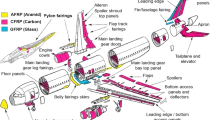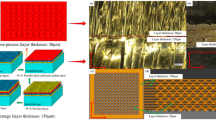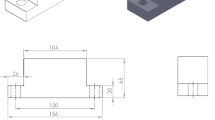Abstract
Titanium alloy materials have been increasingly applied in the field of 3C products. Manufacturers in the production process of 3C products relentlessly pursue high production efficiency, resulting in extremely aggressive selection of process parameters. Extreme machining conditions such as high spindle speed and large feed speed inevitably lead to severe tool wear, making tool cost difficult to control. Therefore, this paper focuses on researching methods to improve the drilling performance and tool life of titanium alloy ultra-high-speed drilling bits, in order to achieve low-cost manufacturing of titanium alloy ultra-high-speed drilling. Firstly, the failure modes and wear mechanisms of drilling bits under ultra-high-speed drilling conditions for titanium alloy materials are analyzed. Secondly, a drilling bit simulation model is established and calibrated through drilling experiments. Then, using the response surface method, design simulation experiments to reveal the influence of geometric parameters on drilling performance and optimize the drilling bit. Finally, based on the optimization results, drilling bits are prepared and drilling performance and tool life experiments are conducted. A comparison with unoptimized bits shows that the optimized drilling bits have significant improvements in drilling performance and tool life.

























Similar content being viewed by others

Data availability
All data generated or analyzed during this study are included in this published article.
References
Liu G, Zhang D, Yao C (2023) Investigation of the grain refinement mechanism in machining Ti-6Al-4V: Experiments and simulations[J]. J Manuf Process 94:479–496. https://doi.org/10.1016/j.jmapro.2023.03.077
He B, Qian S, Li T (2023) Modeling product carbon footprint for manufacturing process[J]. J Clean Prod 402:136805. https://doi.org/10.1016/j.jclepro.2023.136805
Sorgato M, Bertolini R, Ghiotti A, Bruschi S (2023) Tool wear assessment when drilling AISI H13 tool steel multilayered claddings[J]. Wear 524–525:204853. https://doi.org/10.1016/j.wear.2023.204853
Maruda R, Szczotkarz N, Michalski M, Arkusz K, Wojciechowski S, Niesłony P, Khanna N, Królczyk G (2023) Evaluation of tool wear during turning of Ti6Al4V alloy applying MQL technique with Cu nanoparticles diversified in terms of size[J]. Wear 532–533:205111. https://doi.org/10.1016/j.wear.2023.205111
He B, Wu J, Xiao J (2023) Product safety risk assessment approach to sustainable design[J]. Int J Precis Eng Manuf-Green Technol 10:783–788. https://doi.org/10.1007/s40684-022-00490-4
Qinglong A, Yang J, Li J, Liu G, Chen M, Li C (2024) A state-of-the-art review on the intelligent tool holders in machining[J]. Intell Sustain Manuf 1(1):10002. https://doi.org/10.35534/ism.2024.10002
Oliaei S, Karpat Y, Davim J, Perveen A (2018) Micro tool design and fabrication: a review[J]. J Manuf Process 36:496–519. https://doi.org/10.1016/j.jmapro.2018.10.038
Yaşar N, Günay M (2019) Experimental investigation on novel drilling strategy of CFRP laminates using variable feed rate[J]. J Braz Soc Mech Sci Eng 41:150. https://doi.org/10.1007/s40430-019-1658-2
Kubher S, Gururaja S, Zitoune R (2022) Coupled thermo-mechanical modeling of drilling of multi-directional polymer matrix composite laminates[J]. Compos A Appl Sci Manuf 156:106802. https://doi.org/10.1016/j.compositesa.2022.106802
Huang X, Jiang F, Wang Z, Wu X, Huang S, Liu Y, Zhang J, Shi X (2023) A review on the balancing design of micro drills[J]. Int J Adv Manuf Technol 126:4849–4871. https://doi.org/10.1007/s00170-023-11496-w
Pivkin P, Grechishnikov V, Ershov A, Grigoriev S (2021) A new method definition of cutting surface of drills by image processing flank surface[J]. SPIE Future Sens Technol 14:1191413. https://doi.org/10.1117/12.2605834
Liang Z, Guo H, Wang X, Ma Y, Zhou T, Sun X, Jiang L (2020) Influence of chisel edge axial rake angle on the drilling performance of helical point micro-drill[J]. Int J Adv Manuf Technol 107:2137–2149. https://doi.org/10.1007/s00170-020-05180-6
Xu J, Geier N, Shen J, Krishnaraj V, Samsudeensadham S (2023) A review on CFRP drilling: fundamental mechanisms, damage issues, and approaches toward high-quality drilling[J]. J Market Res 24:9677–9707. https://doi.org/10.1016/j.jmrt.2023.05.023
Sadeghifar M, Javidikia M, Songmene V, Jahazi M (2020) Finite element simulation-based predictive regression modeling and optimum solution for grain size in machining of Ti6Al4V alloy: influence of tool geometry and cutting conditions[J]. Simul Model Pract Theory 104:102141. https://doi.org/10.1016/j.simpat.2020.102141
Yang H, Jiang F, Wu X, Zhao G, Shi X, Liu G, Wang M (2023) Optimizing the cutting edge geometry of micro drill based on the entropy weight method[J]. Int J Adv Manuf Technol 125:2673–2689. https://doi.org/10.1007/s00170-023-10884-6
Pedroso A, Sousa V, Sebbe N, Silva F, Campilho R, Sales-Contini R, Jesus A (2023) A Comprehensive review on the conventional and non-conventional machining and tool-wear mechanisms of INCONEL. Metals 13(3):585. https://doi.org/10.3390/met13030585
Zhu Z, Guo K, Sun J, Li J, Liu Y, Zheng Y, Chen L (2018) Evaluation of novel tool geometries in dry drilling aluminium 2024–T351/titanium Ti6Al4V stack[J]. J Mater Process Technol 259:270–281. https://doi.org/10.1016/j.jmatprotec.2018.04.044
Jia Z, Bai Y, Wang F, Wang F, Ma J, Cheng D, Zhang Z (2019) Effect of drill flute direction on delamination at the exit in drilling carbon fiber reinforced plastic[J]. Polym Compos 40(S2):1434–1440. https://doi.org/10.1002/pc.25040
Sui S, Song G, Sun C, Zhu Z, Guo K, Sun J (2020) Experimental investigation on the performance of novel double cone integrated tool in one-shot drilling of metal stacks[J]. Int J Adv Manuf Technol 109:523–534. https://doi.org/10.1007/s00170-020-05474-9
Hajdu D, Astarloa A, Kovacs I, Dombovari Z (2023) The curved uncut chip thickness model: a general geometric model for mechanistic cutting force predictions[J]. Int J Mach Tools Manuf 188:104019. https://doi.org/10.1016/j.ijmachtools.2023.104019
Atif M, Wang X, Xie L, Sun T, Giasin K, Ma Y (2024) Influence of cutting tool design on ultrasonic-assisted drilling of fiber metal laminates[J]. Int J Adv Manuf Technol 131:6039–6059. https://doi.org/10.1007/s00170-024-13128-3
Hasan M, Zhao J, Jiang Z (2017) A review of modern advancements in micro drilling techniques[J]. J Manuf Process 29:343–375. https://doi.org/10.1016/j.jmapro.2017.08.006
Liu H, Xu X, Zhang J, Liu Z, He Y, Zhao W, Liu Z (2022) The state of the art for numerical simulations of the effect of the microstructure and its evolution in the metal-cutting processes[J]. Int J Mach Tools Manuf 177:0890–6955. https://doi.org/10.1016/j.ijmachtools.2022.103890
Arunkumar N, Ganesh M, Rajaram M, Kumar E (2023) Deep hole drilling of AISI 1045: effect on hole quality & tool wear under flood, emulsion, and mist cooling technique[J]. J Braz Soc Mech Sci Eng 45:195. https://doi.org/10.1007/s40430-023-04123-y
Chenegrin K, Roux J, Helfenstein-Didier C, Pouvreau C, Girinon M, Karaouni H, Bergheau J, Feulvarch E (2021) 3D numerical simulation of heat transfer during dry drilling of Inconel 718[J]. J Manuf Process 64:1143–1152. https://doi.org/10.1016/j.jmapro.2021.02.041
Lv C, Wang G, Chen H (2021) Inverse determination of thermal boundary condition and temperature distribution of workpiece during drilling process[J]. Measurement 171:108822. https://doi.org/10.1016/j.measurement.2020.108822
Zhang L, Wang G, Xu X, Xuan S, Fan X, Kan Y, Yao X (2023) Thermal–mechanical coupling numerical simulation and low damage analysis for drilling composite[J]. Compos Struct 324:117542. https://doi.org/10.1016/j.compstruct.2023.117542
Liang Z, Ma Y, Zhang S, Wang X, Chen J, Jiang L, Sun X, Li Y (2021) Novel micro-deep-hole drill with variable web thickness and flute width[J]. Precis Eng 72:340–355. https://doi.org/10.1016/j.precisioneng.2021.05.008
Biermann D, Amuth R, Hess S, Tiffe M (2018) Simulation based analysis and optimisation of the cutting edge micro shape for machining of nickel-base alloys[J]. Procedia CIRP 67:284–289. https://doi.org/10.1016/j.procir.2017.12.214
Siregar I, Saedon J, Adenan M, Azmi M, Harun A (2019) Design, develop and simulate microdrilling cutting tool[J]. IOP Conf Ser: Mater Sci Eng 505(1):012094. https://doi.org/10.1088/1757-899X/505/1/012094
Liu H, Rodrigues L, Meurer M, Bergs T (2023) A three-dimensional analytical model for transient tool temperature in cutting processes considering convection[J]. CIRP J Manuf Sci Technol 43:1–14. https://doi.org/10.1016/j.cirpj.2023.02.003
Zhu Z, Sun X, Guo K, Sun J, Li J (2022) Recent advances in drilling tool temperature: a state-of-the-art review[J]. Chinese J Mech Eng 35:148. https://doi.org/10.1186/s10033-022-00818-w
Tekaüt İ (2023) Investigation of the microstructure, machinability and hole quality of AISI 1045 steel forged at different temperatures[J]. Proc Inst Mech Eng Part E: J Proc Mech Eng 237(5):1866–1877. https://doi.org/10.1177/09544089221138537
Zou F, Chen J, An Q, Cai X, Chen M (2020) Influences of clearance angle and point angle on drilling performance of 2D Cf/SiC composites using polycrystalline diamond tools[J]. Ceram Int 46(4):4371–4380. https://doi.org/10.1016/j.ceramint.2019.10.161
Ficici F (2023) Investigation of wear mechanism in drilling of PPA composites for automotive industry[J]. J Eng Res 11(2):100034. https://doi.org/10.1016/j.jer.2023.100034
Funding
This study is co-supported by the National Natural Science Foundation of China (52305446), the Project of Changzhou Basic Research Program (No. CJ20235067), the general project of basic science (natural science) research in colleges and universities of Jiangsu Province (No. 22KJB460014), and the Open Project of the Key Laboratory of High Performance Manufacturing for Aero Engine (Northwestern Polytechnical University) (No. HPM-2022–01).
Author information
Authors and Affiliations
Contributions
All authors contributed to the study’s conception and design. Qi Wang wrote the paper and carried out the experiments, Xi Chen provided data analysis, Qinglong An designed the framework of the paper, Ming Chen contributed to the main idea of the paper, Hun Guo provided the experimental condition, and Yafeng He helped with the experiments. All authors read and approved the final manuscript.
Corresponding author
Ethics declarations
Ethics approval
Not applicable.
Consent to participate
Not applicable.
Consent for publication
All authors have read and agreed to the published version of the paper.
Conflict of interest
The authors declare no competing interests.
Additional information
Publisher's Note
Springer Nature remains neutral with regard to jurisdictional claims in published maps and institutional affiliations.
Rights and permissions
Springer Nature or its licensor (e.g. a society or other partner) holds exclusive rights to this article under a publishing agreement with the author(s) or other rightsholder(s); author self-archiving of the accepted manuscript version of this article is solely governed by the terms of such publishing agreement and applicable law.
About this article
Cite this article
Chen, X., Wang, Q., An, Q. et al. Research on drilling performance and tool life improvement methods of titanium alloy ultra-high-speed drilling bits. Int J Adv Manuf Technol (2024). https://doi.org/10.1007/s00170-024-13756-9
Received:
Accepted:
Published:
DOI: https://doi.org/10.1007/s00170-024-13756-9



